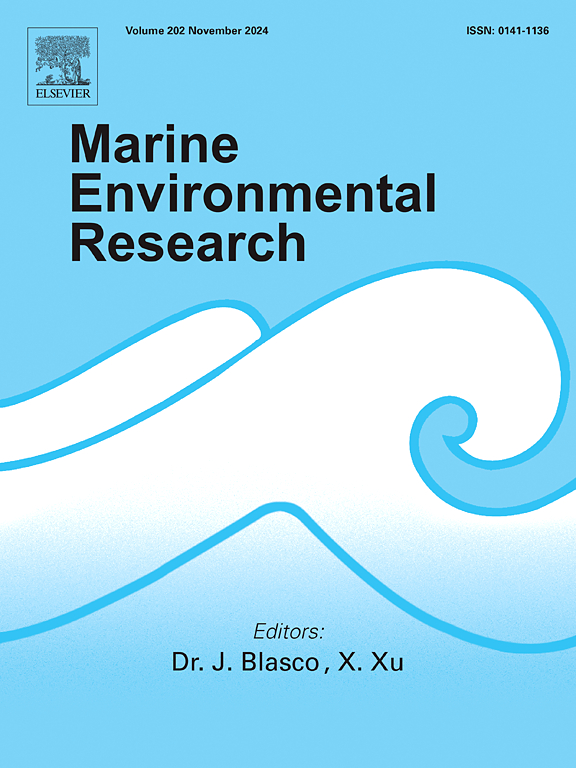不同密度的 Asparagopsis armata(Harvey,1855 年)海藻对蛤蜊 Ruditapes philippinarum(A. Adams and Reeve,1850 年)的影响:实验室评估的启示
IF 3
3区 环境科学与生态学
Q2 ENVIRONMENTAL SCIENCES
引用次数: 0
摘要
多个入侵物种可能占据同一地理区域。物种之间的相互作用取决于多种因素,而这种相互作用的结果可能是多种多样的。Asparagopsis armata 是一种入侵红藻,其渗出物中含有一种有毒的卤代化合物。本研究在实验室实验中评估了高浓度和低浓度天门冬藻对双壳贝类 Ruditapes philippinarum 的影响。这两种藻类都是欧洲的主要入侵物种,可能共享相同的栖息地。藻类的影响是在不同的生物水平上测量的,采用的是一种综合方法:生物扰动作为沉积物中生物活动和行为的替代物,以及与氧化应激和损伤、能量代谢、解毒和神经传递有关的几种亚细胞生物标志物。生物扰动揭示了渗出物对双壳类动物的影响,暴露在不同数量的藻类中时,大多数参数都会下降,但生物标志物却只有微弱的反应,这表明行为反应与内在生化环境之间可能存在时间上的脱钩。这些结果表明,尽管生物标志物在应对各种情况方面具有公认的潜力,但行为等更高层次的生物组织的替代物,因其整合了较低层次的影响,是应对复杂和鲜为人知的混合压力源的有力工具。本文章由计算机程序翻译,如有差异,请以英文原文为准。

The effects of different densities of Asparagopsis armata (Harvey, 1855) seaweed on the clam Ruditapes philippinarum (A. Adams and Reeve, 1850): Insights from a laboratory assessment
Several invasive species can occupy the same geographic area. Interaction between species depends on several factors, and the results of such interactions can be highly diverse. Asparagopsis armata is a invasive red seaweed whose exudates contain a cocktail of toxic halogenated compounds. In this study, the impact of high and low levels of A. armata on the bivalve Ruditapes philippinarum was assessed in a laboratory experiment. Both are prominent invasive species in Europe and could share the same habitats. The effects of the algae were measured at different biological levels, framed by an integrated approach: bioturbation as a proxy for organismal activity and behaviour within the sediment, and several subcellular biomarkers related to oxidative stress and damage, energy metabolism, detoxification, and neurotransmission. While bioturbation revealed the effects of exudates on the bivalve, with a decrease in most parameters when exposed to the different amounts of algae, only marginal responses were found for biomarkers, suggesting a possible temporal decoupling between the behavioural response and the intrinsic biochemical environment. These results denote that despite the recognized potential of biomarkers to address a myriad of situations, a proxy for higher levels of biological organization, such as behaviour, for its integration of lower-level effects, is a robust tool to address complex and lesser-known mixtures of stressors.
求助全文
通过发布文献求助,成功后即可免费获取论文全文。
去求助
来源期刊

Marine environmental research
环境科学-毒理学
CiteScore
5.90
自引率
3.00%
发文量
217
审稿时长
46 days
期刊介绍:
Marine Environmental Research publishes original research papers on chemical, physical, and biological interactions in the oceans and coastal waters. The journal serves as a forum for new information on biology, chemistry, and toxicology and syntheses that advance understanding of marine environmental processes.
Submission of multidisciplinary studies is encouraged. Studies that utilize experimental approaches to clarify the roles of anthropogenic and natural causes of changes in marine ecosystems are especially welcome, as are those studies that represent new developments of a theoretical or conceptual aspect of marine science. All papers published in this journal are reviewed by qualified peers prior to acceptance and publication. Examples of topics considered to be appropriate for the journal include, but are not limited to, the following:
– The extent, persistence, and consequences of change and the recovery from such change in natural marine systems
– The biochemical, physiological, and ecological consequences of contaminants to marine organisms and ecosystems
– The biogeochemistry of naturally occurring and anthropogenic substances
– Models that describe and predict the above processes
– Monitoring studies, to the extent that their results provide new information on functional processes
– Methodological papers describing improved quantitative techniques for the marine sciences.
 求助内容:
求助内容: 应助结果提醒方式:
应助结果提醒方式:


